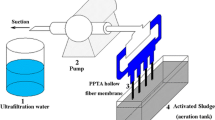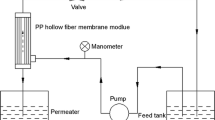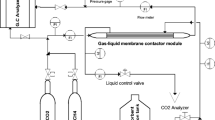Abstract
Polyurethane/graphene (PU/GE) hollow fiber membranes made of a chemically foamed PU/GE spongy layer and inner reinforced poly(ethylene terephthalate) (PET) tubular braids were prepared by a one-step online chemically foamed method. Online chemical foaming involved the simultaneous formation of membrane pores with reaction to form PU by controlling the reaction rate. The hydrophobicity and lipophilicity of the membrane were increased by the introduction of GE, which as a heterogeneous bubble nucleating agent increased the bubble density. The properties of PU/GE hollow fiber membranes were investigated by testing of the micro-morphology, contact angles of different liquids, oil/water separation and membrane reusability. The experimental results showed that when GE was introduced into the foaming solutions, the hydrophobicity of the prepared membrane was increased and the thermal stability of the membrane was improved. With the increase in GE content, the pore size, porosity and pure oil flux of the chemically foamed PU/GE hollow fiber membranes first decreased and then increased, and the inverse change was observed with the liquid osmotic pressure. When GE content was 1.8 wt%, PU/GE hollow fiber membranes exhibited superior membrane performance, with separation efficiency as high as 90% and high flux (143 L·m−2·h−1 at −0.5 bar). The PU/GE hollow fiber membrane could be applied to continuous oil/water separation experiments. In addition, PU/GE hollow fiber membranes showed durability and reusability, and the flux recovery rate was kept above 90%.














Similar content being viewed by others
References
Fried JR (2000) Polymer Science and Technology. CRC press, Boca Raton
Gunashekar S, Abu-Zahra N (2016) Structure–performance relationship of bulk functionalized polyurethane foams designed for lead ion removal from water. J Porous Mater 23(3):801–810
Toyoda M, Aizawa J, Inagaki M (2003) Sorption and recovery of heavy oil by using exfoliated graphite. Spill Sci Technol Bull 8(5):467–474
Dalton T, Jin D (2010) Extent and frequency of vessel oil spills in US marine protected areas. Mar Pollut Bull 60(11):1939–1945
Liu C, Yang J, Tang Y, Yin L, Tang H, Li C (2015) Versatile fabrication of the magnetic polymer-based graphene foam and applications for oil–water separation. Colloids Surf A Physicochem Eng Asp 468:10–16
Krebs T, Schroën C, Boom RM (2012) Separation kinetics of an oil-in-water emulsion under enhanced gravity. Chem Eng Sci 71:118–125
Santander M, Rodrigues RT, Rubio J (2011) Modified jet flotation in oil (petroleum) emulsion/water separations. Colloids Surf A Physicochem Eng Asp 375(1-3):237–244
Chen X, Lu H, Jiang W, Chu L, Liang B (2010) De-emulsification of Kerosene/Water Emulsions with Plate-Type Microchannels. Ind Eng Chem Res 49(19):9279–9288
Bratskaya S, Avramenko V, Schwarz S, Philippova I (2006) Enhanced flocculation of oil-in-water emulsions by hydrophobically modified chitosan derivatives. Colloids Surf A Physicochem Eng Asp 275(1-3):168–176
Dong X, Chen J, Ma Y, Wang J, Chan-park M, Liu X, Wang L, Huang W, Chen P (2012) Superhydrophobic and superoleophilic hybrid foam of graphene and carbon nanotube for selective removal of oils or organic solvents from the surface of water. Chem Commun 48(86):10660–10662
Tsai CK, Liao CY, Wang HP, Chien Y, Jou G (2008) Pyrolysis of spill oils adsorbed on zeolites with product oils recycling. Mar Pollut Bull 57(6-12):895–898
Cong HP, Ren XC, Wang P, Yu SH (2012) Macroscopic Multifunctional Graphene-Based Hydrogels and Aerogels by a Metal Ion Induced Self-Assembly Process. ACS Nano 6(3):2693–2703
Choi SJ, Kwon TH, Im H, Moon D, Baek DJ, Seol ML, Duarte JP, Choi YK (2011) A Polydimethylsiloxane (PDMS) Sponge for the Selective Absorption of Oil from Water. ACS Appl Mater Interfaces 3(12):4552–4556
Banerjee A, Gokhale R, Bhatnagar S, Jog J, Bhardwaj M, Lefez B, Hannoyer B, Ogale S (2012) MOF derived porous carbon–Fe3O4 nanocomposite as a high performance, recyclable environmental superadsorbent. J Mater Chem 22(37):19694–19699
Chu Y, Pan Q (2012) Three-Dimensionally Macroporous Fe/C Nanocomposites As Highly Selective Oil-Absorption Materials. ACS Appl Mater Interfaces 4(5):2420–2425
Gui X, Zeng Z, Lin Z, Gan Q, Xiang R, Zhu Y, Cao A, Tang Z (2013) Magnetic and Highly Recyclable Macroporous Carbon Nanotubes for Spilled Oil Sorption and Separation. ACS Appl Mater Interfaces 5(12):5845–5850
Bi H, Yin Z, Cao X, Xie X, Tan C, Huang X, Chen B, Chen F, Yang Q, Bu X, Lu X, Sun L, Zhang H (2013) Carbon Fiber Aerogel Made from Raw Cotton: A Novel, Efficient and Recyclable Sorbent for Oils and Organic Solvents. Adv Mater 25(41):5916–5921
Song J, Huang S, Lu Y, Megaridis C (2014) Self-Driven One-Step Oil Removal from Oil Spill on Water via Selective-Wettability Steel Mesh. ACS Appl Mater Interfaces 6(22):19858–19865
Zhu Q, Pan Q, Liu F (2011) Facile Removal and Collection of Oils from Water Surfaces through Superhydrophobic and Superoleophilic Sponges. J Phys Chem C 115(35):17464–17470
Zhang T, Xiao CF, Zhao J, Chen KK, Hao JQ, Ji DW (2018) Continuous separation of oil from water surface by a novel tubular unit based on graphene coated polyurethane sponge. Polym Adv Technol 29(8):2317–2326
Khosravi M, Azizian S (2015) Synthesis of a Novel Highly Oleophilic and Highly Hydrophobic Sponge for Rapid Oil Spill Clean up. ACS Appl Mater Interfaces 7(45):25326–25333
Zhang L, Yilmaz ED, Schjødt J (2011) MWNT reinforced polyurethane foam: Processing, characterization and modelling of mechanical properties. Compos Sci Technol 71(6):877–884
Harikrishnan G, Singh SN, Kiesel E, Macosko CW (2010) Nanodispersions of carbon nanofiber for polyurethane foaming. Polymer 51(15):3349–3353
Zhang F, Xiao Z, Huang J, Zhang Q (2011) One-pot synthesized polyurethane-based nanocomposites filled by original rectorite with enhanced strength and elongation. Journal of Wuhan University of Technology-Mater Sci Ed 26(3):483–490
Chuayjuljit S, Maungchareon A, Saravari O (2010) Preparation and properties of palm oil-based rigid polyurethane nanocomposite foams. J Reinf Plast Compos 29:218–225
Sarier N, Onder E (2010) Organic modification of montmorillonite with low molecular weight polyethylene glycols and its use in polyurethane nanocomposite foams. Thermochim Acta 510(1):113–121
Matsuyama H, Teramoto M, Kudari S, Kitamura Y (2001) Effect of diluents on membrane formation via thermally induced phase separation. J Appl Polym Sci 82(1):169–177
Zeng C, Hossieny N, Zhang C, Wang B (2010) Synthesis and processing of PMMA carbon nanotube nanocomposite foams. Polymer 51(3):655–664
Hurst KM, Roberts CB, Ashurst WR (2010) Characterization of Gas-Expanded Liquid-Deposited Gold Nanoparticle Films on Substrates of Varying Surface Energy. Langmuir 27(2):651–655
Wang H, Huang XW, Li B, Gao JF (2018) Facile preparation of super-hydrophobic nanofibrous membrane for oil/water separation in a harsh environment. J Mater Sci 53(14):10111–10121
Zhu XY, Tu WT, Wee KH, Bai RB (2014) Effective and low fouling oil/water separation by a novel hollow fiber membrane with both hydrophilic and oleophobic surface properties. J Membr Sci 466:36–44
Hao JQ, Xiao CF, Zhang T, Zhao J, Fan ZW, Chen L (2016) Preparation and performance of PET braid reinforced polyvinylidene fluoride/graphene hollow fiber membranes. Ind Eng Chem Res 55(7):2174–2182
Acknowledgments
The authors are grateful for the financial support of the National Natural Science Foundation of China (51673149), National Science Foundation of Tianjin (17JCQNJC02700), and the Industrial Chain Collaborative Innovation Major Projects of the State Oceanic Administration of China (BHSF2017-01).
Author information
Authors and Affiliations
Corresponding author
Additional information
Publisher’s note
Springer Nature remains neutral with regard to jurisdictional claims in published maps and institutional affiliations.
Electronic supplementary material
ESM 1
(DOCX 583 kb)
(MP4 480,341 kb)
Rights and permissions
About this article
Cite this article
Wu, YJ., Xiao, CF. & Liu, HL. Preparation and Performance of Online Chemically Foamed Polyurethane/Graphene Reinforced Membrane. J Polym Res 26, 202 (2019). https://doi.org/10.1007/s10965-019-1841-2
Received:
Accepted:
Published:
DOI: https://doi.org/10.1007/s10965-019-1841-2




